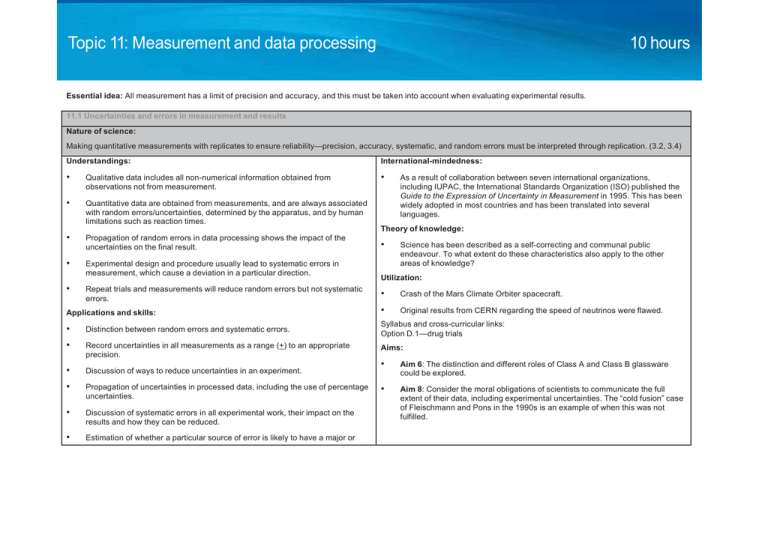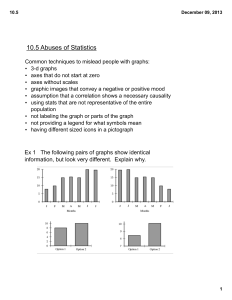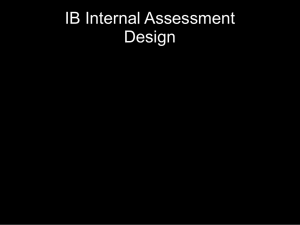Topic 11- Measurement and data processing
advertisement

Topic 11: Measurement and data processing 10 hours Essential idea: All measurement has a limit of precision and accuracy, and this must be taken into account when evaluating experimental results. 11.1 Uncertainties and errors in measurement and results Nature of science: Making quantitative measurements with replicates to ensure reliability—precision, accuracy, systematic, and random errors must be interpreted through replication. (3.2, 3.4) Understandings: International-mindedness: • Qualitative data includes all non-numerical information obtained from observations not from measurement. • • Quantitative data are obtained from measurements, and are always associated with random errors/uncertainties, determined by the apparatus, and by human limitations such as reaction times. • Propagation of random errors in data processing shows the impact of the uncertainties on the final result. • Experimental design and procedure usually lead to systematic errors in measurement, which cause a deviation in a particular direction. • Repeat trials and measurements will reduce random errors but not systematic errors. As a result of collaboration between seven international organizations, including IUPAC, the International Standards Organization (ISO) published the Guide to the Expression of Uncertainty in Measurement in 1995. This has been widely adopted in most countries and has been translated into several languages. Theory of knowledge: • Science has been described as a self-correcting and communal public endeavour. To what extent do these characteristics also apply to the other areas of knowledge? Utilization: • Crash of the Mars Climate Orbiter spacecraft. Applications and skills: • Original results from CERN regarding the speed of neutrinos were flawed. • Distinction between random errors and systematic errors. Syllabus and cross-curricular links: Option D.1—drug trials • Record uncertainties in all measurements as a range (+) to an appropriate precision. Aims: • Discussion of ways to reduce uncertainties in an experiment. • Propagation of uncertainties in processed data, including the use of percentage uncertainties. • Discussion of systematic errors in all experimental work, their impact on the results and how they can be reduced. • Estimation of whether a particular source of error is likely to have a major or • Aim 6: The distinction and different roles of Class A and Class B glassware could be explored. • Aim 8: Consider the moral obligations of scientists to communicate the full extent of their data, including experimental uncertainties. The “cold fusion” case of Fleischmann and Pons in the 1990s is an example of when this was not fulfilled. 11.1 Uncertainties and errors in measurement and results Chemistry guide minor effect on the final result. • Calculation of percentage error when the experimental result can be compared with a theoretical or accepted result. • Distinction between accuracy and precision in evaluating results. Guidance: • The number of significant figures in a result is based on the figures given in the data. When adding or subtracting, the final answer should be given to the least number of decimal places. When multiplying or dividing the final answer is given to the least number of significant figures. • Note that the data value must be recorded to the same precision as the random error. • SI units should be used throughout the programme. Topic 11: Measurement and data processing 73 74 Essential idea: Graphs are a visual representation of trends in data. 11.2 Graphical techniques Nature of science: The idea of correlation—can be tested in experiments whose results can be displayed graphically. (2.8) Understandings: International-mindedness: • Graphical techniques are an effective means of communicating the effect of an independent variable on a dependent variable, and can lead to determination of physical quantities. • • Sketched graphs have labelled but unscaled axes, and are used to show qualitative trends, such as variables that are proportional or inversely proportional. • • Drawn graphs have labelled and scaled axes, and are used in quantitative measurements. Utilization: Applications and skills: • Drawing graphs of experimental results including the correct choice of axes and scale. • Interpretation of graphs in terms of the relationships of dependent and independent variables. • Production and interpretation of best-fit lines or curves through data points, including an assessment of when it can and cannot be considered as a linear function. • Calculation of quantities from graphs by measuring slope (gradient) and intercept, including appropriate units. Charts and graphs, which largely transcend language barriers, can facilitate communication between scientists worldwide. Theory of knowledge: • Graphs are a visual representation of data, and so use sense perception as a way of knowing. To what extent does their interpretation also rely on the other ways of knowing, such as language and reason? Graphical representations of data are widely used in diverse areas such as population, finance and climate modelling. Interpretation of these statistical trends can often lead to predictions, and so underpins the setting of government policies in many areas such as health and education. Syllabus and cross-curricular links: Topic 1.3—gas volume, temperature, pressure graphs Topic 6.1—Maxwell–Boltzmann frequency distribution; concentration–time and rate– concentration graphs Topic 16.2—Arrhenius plot to determine activation energy Topic 18.3—titration curves Option B.7—enzyme kinetics Option C.5—greenhouse effect; carbon dioxide concentration and global temperatures Option C.7—first order/decay graph Aims: • Aim 7: Graph-plotting software may be used, including the use of spreadsheets and the derivation of best-fit lines and gradients. Chemistry guide 75



